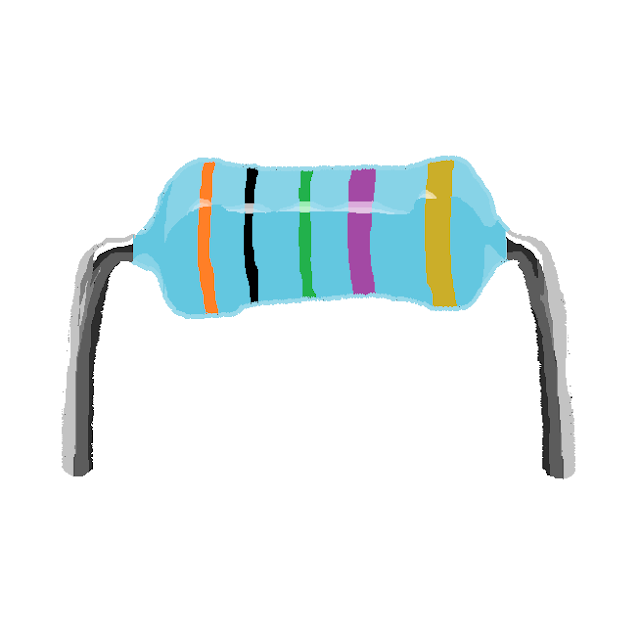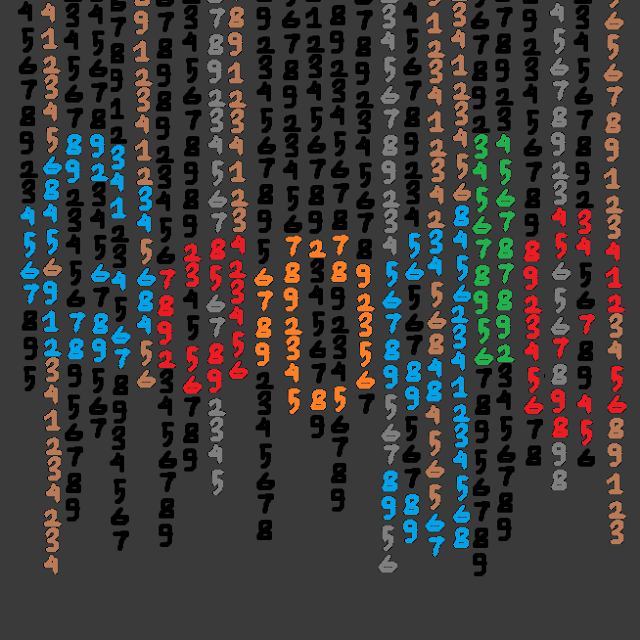How To Calculate Resistance Value From Resistor Stripe Color | 4, 5, And 6 Stripes
The resistor is an electronic component that is used to adjust the electric current in a circuit. Its shape is like a small cylinder that is a little bit slimmer in the middle. There usually is some color stripes that embedded on them, commonly four, but can also have five to six stripes.
Here is the table of each value the colors represent:
Color | Number Represented | Multiplier | Tolerance (%) | Temperature Coefficient (ppm/oC) |
Black | 0 | 100 or 1 | - | - |
Brown | 1 | 101 or 10 | ± 1 | 100 |
Red | 2 | 102 or 100 | ± 2 | 50 |
Orange | 3 | 103 or 1000 | - | 15 |
Yellow | 4 | 104 or 10000 | - | 25 |
Green | 5 | 105 or 100000 | ± 0.5 | - |
Blue | 6 | 106 or 1000000 | ± 0.25 | - |
Violet | 7 | 107 or 10000000 | ± 0.1 | - |
Grey | 8 | 108 or 100000000 | - | - |
White | 9 | 109 or 1000000000 | - | - |
Gold | - | 10-1 or 0.1 | ± 5 | - |
Silver | - | 10-2 or 0.01 | ± 10 | - |
No Color | - | - | ± 20 | - |
Note:
- Gold and silver color usually seem shiny.
- Temperature coefficient signifies a change of resistance when there's temperature alteration. The base temperature is the room temperature (25oC).
How to Calculate
 |
4 Stripes Formula |
Four Striped Resistor
1st stripe: 1st digit
2nd stripe: 2nd digit
3rd stripe: multiplier
4th stripe: tolerance
Example:
 |
4 Stripes Example 1 |
1st stripe: red = 2
2nd stripe: black = 0
3rd stripe: orange = 103
4th stripe: no colors = ± 20%
so its resistance is
20 x 103 ± 20% Ω
or 20000 ± 20% Ω
or 20 ± 20% kΩ
or 20 ± 4 kΩ
or 16 ~ 24 kΩ
Note:
- How to know "no color" stripe? When there are only three stripes, it means the 4th is "no color" stripe because there's no three-striped only resistor.
- "No color" does not represent any number so they can only become later stripe not the 1st or 2nd stripe, so it becomes the 4th stripe.
- "No color" stripe should only work for four-striped resistor as it's disorientating for the five and six-striped resistor.
 |
4 Stripes Example 2 |
1st stripe: green = 5
2nd stripe: blue = 6
3rd stripe: red = 102
4th stripe: silver = ± 10%
so its resistance is
56 x 102 ± 10% Ω
or 5600 ± 10% Ω
or 5.6 ± 10% kΩ
or 5.6 ± 0.56 kΩ
or 5.04 ~ 6.16 kΩ
Note:
- Silver does not represent any number so they can only become later stripe, not the 1st or 2nd stripe, so it becomes the 4th stripe.
 |
4 Stripes Example 3 |
1st stripe: red = 2
2nd stripe: violet = 7
3rd stripe: yellow = 104
4th stripe: gold = ± 5%
so its resistance is
27 x 104 ± 5% Ω
or 270000 ± 5% Ω
or 270 ± 5% kΩ
or 270 ± 13.5 kΩ
or 256.5 ~ 283.5 kΩ
Note:
- Gold does not represent any number so they can only become later stripe not the 1st or 2nd stripe, so it becomes the 4th stripe.
Five Striped Resistor
 |
5 Stripes Formula |
1st stripe: 1st digit
2nd stripe: 2nd digit
3rd stripe: 3rd digit
4th stripe: multiplier
5th stripe: tolerance
Example:
 |
5 Stripes Example 1 |
1st stripe: white = 9
2nd stripe: yellow = 4
3rd stripe: orange = 3
4th stripe: brown = 101
5th stripe: violet = ± 0.1%
so its resistance is
943 x 101 ± 0.1% Ω
or 9430 ± 0.1% Ω
or 9.43 ± 0.1% kΩ
or 9.43 ± 0.943 kΩ
or 8.487 ~ 10.373 kΩ
Note:
- Why yellow as the 1st stripe? Because it doesn't represent any tolerance value at all, so it can't be the 5th stripe rather than violet.
 |
5 Stripes Example 2 |
1st stripe: yellow = 4
2nd stripe: blue = 5
3rd stripe: grey = 8
4th stripe: brown = 101
5th stripe: brown = ± 1%
so its resistance is
458 x 101 ± 1% Ω
or 4580 ± 1% Ω
or 4.58 ± 1% kΩ
or 4.58 ± 0.458 kΩ
or 4.022 ~ 5.038 kΩ
Note:
- Why yellow as the 1st stripe? Because it doesn't represent any tolerance value at all, so it can't be the 5th stripe instead of brown.
 |
5 Stripes Example 3 |
1st stripe: red = 2
2nd stripe: red = 2
3rd stripe: violet = 7
4th stripe: gold = 10-1
5th stripe: green = ± 0.5%
so its resistance is
227 x 10-1 ± 0.5% Ω
or 22.7 ± 0.5% Ω
or 22.7 ± 0.1135 Ω
or 22.5865 ~ 22.8135 Ω
Note:
- Because gold doesn't represent a number, it can't be the 2nd stripe, it can only become the later stripe, so it is the 4th stripe.
Six Striped Resistor
 |
6 Stripes Formula |
1st stripe: 1st digit
2nd stripe: 2nd digit
3rd stripe: 3rd digit
4th stripe: multiplier
5th stripe: tolerance
6th stripe: temperature coefficient
Example:
 |
6 Stripes Example 1 |
1st stripe: blue = 6
2nd stripe: black = 0
3rd stripe: grey = 8
4th stripe: silver = 10-2
5th stripe: red = ± 2%
6th stripe: yellow = 25 ppm/oC
so its resistance is
608 x 10-2 ± 2% with 25 ppm/oC Ω
or 6.08 ± 2% with 25 ppm/oC Ω
or 6.08 ± 0.1216 with 25 ppm/oC Ω
or 5.9584 ~ 6.2016 with 25 ppm/oC Ω
or 5.9584 ~ 6.2016 Ω with no more than 25 x 10-6 x (5.9584 ~ 6.2016) Ω change of value when there's 1oC of temperature change happened from room temperature (25oC)
or 5.9584 ~ 6.2016 ± ({0.00014896 ~ 0.00015504} / oC) Ω
Note:
- Why blue as the 1st stripe? Because it doesn't have temperature coefficient value at all, so it can't be the 6th stripe instead of yellow.
- Also, because silver doesn't represent a number, it can't be the 3rd stripe, it can only become the later stripe, so it is the 4th stripe.
 |
6 Stripes Example 2 |
1st stripe: red = 2
2nd stripe: yellow = 4
3rd stripe: green = 5
4th stripe: orange = 103
5th stripe: blue = ± 0.25%
6th stripe: red = 50 ppm/oC
so its resistance is
245 x 103 ± 0.25% with 50 ppm/oC Ω
or 245000 ± 0.25% with 50 ppm/oC Ω
or 245 ± 0.25% with 50 ppm/oC kΩ
or 245 ± 0.6125 with 50 ppm/oC kΩ
or 244.3875 ~ 245.6125 with 50 ppm/oC kΩ
or 244.3875 ~ 245.6125 kΩ with no more than 50 x 10-6 x (244.3875 ~ 245.6125) kΩ change of value when there's 1oC of temperature change happened from room temperature (25oC)
or 244.3875 ~ 245.6125 ± ({0.012219375 ~ 0.012280625} / oC) kΩ
Note:
- Why yellow as the 2nd stripe? Because it doesn't have any tolerance value at all, so it can't be the 5th stripe rather than blue.
 |
6 Stripes Example 3 |
1st stripe: white = 9
2nd stripe: black = 0
3rd stripe: grey = 8
4th stripe: yellow = 104
5th stripe: gold = ± 5%
6th stripe: orange = 15 ppm/oC
so its resistance is
908 x 104 ± 5% with 15 ppm/oC Ω
or 9080000 ± 5% with 15 ppm/oC Ω
or 9.08 ± 5% with 15 ppm/oC MΩ
or 9.08 ± 0.454 with 15 ppm/oC MΩ
or 8.626 ~ 9.534 with 15 ppm/oC MΩ
or 8.626 ~ 9.534 MΩ with no more than 15 x 10-6 x (8.626 ~ 9.534) MΩ change of value when there's 1 oC of temperature change happened from room temperature (25oC)
or 8.626 ~ 9.534 ± ({0.00012939 ~ 0.00014301} / oC) MΩ
Note:
- Why white as the first stripe? Because it doesn't represent any temperature coefficient value at all, so it can't be the 6th stripe instead of orange.
- Also, because gold doesn't represent a number, it can't be the 2nd stripe, it can only become the later stripe, so it is the 5th stripe.
In a formula, resistance is symbolized by capital "R", i.e. R = V / I or Resistance is equal to Voltage divided by Current.
The resistor can be used to control, divide, and delays the flow of electric current; control heat; frequency; etc.
Presently, there's also surface mounted technology (SMT) that is replacing the through-hole component. The SMT resistor has numerical values printed on them rather than color stripes. But this technology also said to has increased defect risk.



New Year
ReplyDeletei don't know about electronic study. but it look like good tutorial.
ReplyDelete